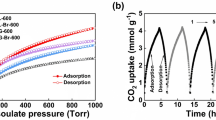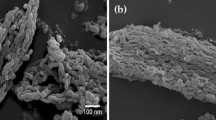Abstract
A simple one step chemical activation involving a relatively mild chemical potassium citrate and inexpensive chitosan as a carbon source is presented for the synthesis of microporous carbons with a high specific surface area. The synthesis avoids the use of a highly corrosive and unfriendly activating agent, KOH, which is generally used for the creation of the porosity. The obtained microporous carbons display a high specific surface area which can be tuned by varying the amount of activating agent (1784–2278 m2 g−1). The optimized material exhibits a high surface area of 2278m2 g−1 and a pore volume of 1.00 cm3 g−1. As high microporosity is beneficial for CO2 adsorption, the prepared materials are employed as adsorbents for the capture of CO2. The optimized sample displays excellent CO2 uptakes at 0 °C/0.15 bar (1.1–1.8 mmol g−1) and 0 °C/1 bar (4.3–6.1 mmol g−1). The high surface area of the materials allows for high CO2 uptakes at 0 °C/30 bar (17.3–22.0 mmol g−1). The microporosity of these high surface area carbons is further decorated with strontium carbonate nanoparticles. The adsorption capacity per unit surface area is increased significantly upon the incorporation of the nanoparticles, revealing the role of the nanoparticles on the enhancement of the CO2 adsorption capacity. A similar strategy could be extended for the fabrication of a series of microporous carbons derived from biomass for many applications including CO2 capture.







Similar content being viewed by others
References
J. Wang, P. Zhang, L. Liu, Y. Zhang, J. Yang, Z. Zeng, S. Deng, Controllable synthesis of bifunctional porous carbon for efficient gas-mixture separation and high-performance supercapacitor. Chem. Eng. J. 348, 57–66 (2018)
Y. Chen, J. Jiang, A bio-metal–organic framework for highly selective CO2 capture: a molecular simulation study. ChemSusChem 3, 982–988 (2010)
Z. Zhang, J. Cai, F. Chen, H. Li, W. Zhang, W. Qi, Progress in enhancement of CO2 absorption by nanofluids: a mini review of mechanisms and current status. Renew. Energy 118, 527–535 (2018)
R. Rodriguez-Mosqueda, E.A. Bramer, G. Brem, CO2 capture from ambient air using hydrated Na2CO3 supported on activated carbon honeycombs with application to CO2 enrichment in greenhouses. Chem. Eng. Sci. 189, 114–122 (2018)
N. Roy, N. Suzuki, C. Terashima, A. Fujishima, Recent improvements in the production of solar fuels: from CO2 reduction to water splitting and artificial photosynthesis. Bull. Chem. Soc. Jpn. 92, 178–192 (2019)
Y. Wang, X. Liu, A. Kraslawski, J. Gao, P. Cui, A novel process design for CO2 capture and H2S removal from the syngas using ionic liquid. J. Clean. Prod. 213, 480–490 (2019)
A.W. Sakti, Y. Nishimura, H. Sato, H. Nakai, Divide-and-conquer density-functional tight-binding molecular dynamics study on the formation of carbamate ions during CO2 chemical absorption in aqueous amine solution. Bull. Chem. Soc. Jpn. 90, 1230–1235 (2017)
Y.G. Huang, S.Q. Wu, W.H. Deng, G. Xu, F.L. Hu, J.P. Hill, W. Wei, S.Q. Su, L.K. Shrestha, O. Sato, Selective CO2 capture and high proton conductivity of a functional Star-of-David Catenane metal–organic framework. Adv. Mater. 29, 1703301 (2017)
M. Nowrouzi, H. Younesi, N. Bahramifar, Superior CO2 capture performance on biomass-derived carbon/metal oxides nanocomposites from Persian ironwood by H3PO4 activation. Fuel 223, 99–114 (2018)
I. Duran, F. Rubiera, C. Pevida, Microalgae: potential precursors of CO2 adsorbents. J. CO2 Util 26, 454–464 (2018)
Y. Sun, K. Li, J. Zhao, J. Wang, N. Tang, D. Zhang, T. Guan, Z. Jin, Nitrogen and sulfur Co-doped microporous activated carbon macro-spheres for CO2 capture. J. Colloid Interface Sci. 526, 174–183 (2018)
G. Singh, I.Y. Kim, K.S. Lakhi, P. Srivastava, R. Naidu, A. Vinu, Single step synthesis of activated bio-carbons with a high surface area and their excellent CO2 adsorption capacity. Carbon 116, 448–455 (2017)
P. Lahijani, M. Mohammadi, A.R. Mohamed, Metal incorporated biochar as a potential adsorbent for high capacity CO2 capture at ambient condition. J. CO2 Util 26, 281–293 (2018)
G. Singh, K.S. Lakhi, C.I. Sathish, K. Ramadass, J.-H. Yang, A. Vinu, Oxygen-functionalized mesoporous activated carbons derived from casein and their superior CO2 adsorption capacity at both low- and high-pressure regimes. ACS Appl. Nano Mater 2, 1604–1613 (2019)
C. Xu, C.-Q. Ruan, Y. Li, J. Lindh, M. Stromme, High-performance activated carbons synthesized from nanocellulose for CO2 capture and extremely selective removal of volatile organic compounds. Adv. Sustainable Syst 2, 1–11 (2018)
G. Singh, K.S. Lakhi, K. Ramadass, C.I. Sathish, A. Vinu, High-performance biomass-derived activated porous biocarbons for combined pre- and post-combustion CO2 capture. ACS Sustain. Chem. Eng. 7, 7412–7420 (2019)
Y. Liu, Y. Zhao, K. Li, Z. Wang, P. Tian, D. Liu, T. Yang, J. Wang, Activated carbon derived from chitosan as air cathode catalyst for high performance in microbial fuel cells. J. Power Sources 378, 1–9 (2018)
Q. Zhou, J. Chang, Y. Jiang, T. Wei, L. Sheng, Z. Fan, Fast charge rate supercapacitors based on nitrogen-doped aligned carbon nanosheet networks. Electrochim. Acta 251, 91–98 (2017)
J. Ou, L. Yang, Z. Zhang, X. Xi, Nitrogen-doped porous carbon derived from horn as an advanced anode material for sodium ion batteries. Microporous Mesoporous Mater. 237, 23–30 (2017)
A. Dandekar, R.T.K. Baker, M.A. Vannice, Characterization of activated carbon, graphitized carbon fibers and synthetic diamond powder using TPD and DRIFTS. Carbon 36, 1821–1831 (1998)
G. Singh, K.S. Lakhi, I.Y. Kim, S. Kim, P. Srivastava, R. Naidu, A. Vinu, Highly efficient method for the synthesis of activated mesoporous biocarbons with extremely high surface area for high-pressure CO2 adsorption. ACS Appl. Mater. Interfaces 9, 29782–29793 (2017)
D. Rautaray, A. Sanyal, S.D. Adyanthaya, A. Ahmad, M. Sastry, Biological synthesis of strontium carbonate crystals using the fungus Fusarium oxysporum. Langmuir 20, 6827–6833 (2004)
F. Davar, M. Salavati-Niasari, S. Baskoutas, Temperature controlled synthesis of SrCO3 nanorods via a facile solid-state decomposition rout starting from a novel inorganic precursor. Appl. Surf. Sci. 257, 3872–3877 (2011)
H. Li, F. Liu, X. Ma, Z. Wu, Y. Li, L. Zhang, S. Zhou, Y. Helian, Catalytic performance of strontium oxide supported by MIL–100(Fe) derivate as transesterification catalyst for biodiesel production. Energy Convers. Manag. 180, 401–410 (2019)
Y. Duan, J. Li, X. Yang, X.-M. Cao, L. Hu, Z.-Y. Wang, Y.-W. Liu, C.-X. Wang, Thermal investigation of strontium acetate hemihydrate in nitrogen gas. J. Therm. Anal. Calorim. 94, 169–174 (2008)
W. Tongpoothorn, M. Sriuttha, P. Homchan, S. Chanthai, C. Ruangviriyachai, Preparation of activated carbon derived from Jatropha curcas fruit shell by simple thermo-chemical activation and characterization of their physico-chemical properties. Chem. Eng. Res. Des. 89, 335–340 (2011)
N.F. Cardoso, E.C. Lima, B. Royer, M.V. Bach, G.L. Dotto, L.A.A. Pinto, T. Calvete, Comparison of Spirulina platensis microalgae and commercial activated carbon as adsorbents for the removal of reactive red 120 dye from aqueous effluents. J. Hazard. Mater. 241-242, 146–153 (2012)
M. Prekajski, M. Mirković, B. Todorović, A. Matković, M. Marinović-Cincović, J. Luković, B. Matović, Ouzo effect—new simple nanoemulsion method for synthesis of strontium hydroxyapatite nanospheres. J. Eur. Ceram. Soc. 36, 1293–1298 (2016)
G. Singh, I.Y. Kim, K.S. Lakhi, S. Joseph, P. Srivastava, R. Naidu, A. Vinu, Heteroatom functionalized activated porous biocarbons and their excellent performance for CO2 capture at high pressure. J. Mater. Chem. A 5, 21196–21204 (2017)
Y. Xia, R. Mokaya, G.S. Walker, Y. Zhu, Superior CO2 adsorption capacity on N-doped, high-surface-area, microporous carbons templated from zeolite. Adv. Energy Mater. 1, 678–683 (2011)
W. Lu, J.P. Sculley, D. Yuan, R. Krishna, Z. Wei, H.-C. Zhou, Polyamine-tethered porous polymer networks for carbon dioxide capture from flue gas. Angew. Chem. Int. Ed. 51, 7480–7484 (2012)
C.F. Martín, E. Stöckel, R. Clowes, D.J. Adams, A.I. Cooper, J.J. Pis, F. Rubiera, C. Pevida, Hypercrosslinked organic polymer networks as potential adsorbents for pre-combustion CO2 capture. J. Mater. Chem. 21, 5475–5483 (2011)
S. Kim, J. Ida, V.V. Guliants, Y. Lin, Tailoring pore properties of MCM-48 silica for selective adsorption of CO2. J. Phys. Chem. B 109, 6287–6293 (2005)
K.S. Lakhi, G. Singh, S. Kim, A.V. Baskar, S. Joseph, J.-H. Yang, H. Ilbeygi, S.J. Ruban, V.T. Vu, A. Vinu, Mesoporous Cu-SBA-15 with highly ordered porous structure and its excellent CO2 adsorption capacity. Microporous Mesoporous Mater. 267, 134–141 (2018)
M.G. Singh, K.S. Lakhi, D.H. Park, P. Srivastava, R. Naidu, A. Vinu, Facile one-pot synthesis of activated porous biocarbons with a high nitrogen content for CO2 capture. ChemNanoMat 4, 281–290 (2018)
S. Himeno, T. Komatsu, S. Fujita, High-pressure adsorption equilibria of methane and carbon dioxide on several activated carbons. J. Chem. Eng. Data 50, 369–376 (2005)
L.F. Zubeir, M.H.M. Lacroix, J. Meuldijk, M.C. Kroon, A.A. Kiss, Novel pressure and temperature swing processes for CO2 capture using low viscosity ionic liquids. Sep. Purif. Technol. 204, 314–327 (2018)
P. Nachtigall, L. Grajciar, J. Pérez-Pariente, A.B. Pinar, A. Zukal, J. Čejka, Control of CO2 adsorption heats by the Al distribution in FER zeolites. Phys. Chem. Chem. Phys. 14, 1117–1120 (2012)
L. Grajciar, J. Čejka, A. Zukal, C. Otero Areán, G. Turnes Palomino, P. Nachtigall, Controlling the adsorption enthalpy of CO2 in zeolites by framework topology and composition. ChemSusChem 5, 2011–2022 (2012)
G. Singh, K.S. Lakhi, S. Sil, S.V. Bhosale, I. Kim, K. Albahily, A. Vinu, Biomass derived porous carbon for CO2 capture. Carbon 148, 164–186 (2019)
G. Singh, K.S. Lakhi, K. Ramadass, S. Kim, D. Stockdale, A. Vinu, A combined strategy of acid-assisted polymerization and solid state activation to synthesize functionalized nanoporous activated biocarbons from biomass for CO2 capture. Microporous Mesoporous Mater. 271, 23–32 (2018)
A.T. Zukal, I. Dominguez, J. Mayerová, J.I. Čejka, Functionalization of delaminated zeolite ITQ-6 for the adsorption of carbon dioxide. Langmuir 25, 10314–10321 (2009)
H.J. Park, M.P. Suh, Enhanced isosteric heat, selectivity, and uptake capacity of CO2 adsorption in a metal-organic framework by impregnated metal ions. Chem. Sci. 4, 685–690 (2013)
Q. Li, J. Yang, D. Feng, Z. Wu, Q. Wu, S.S. Park, C.-S. Ha, D. Zhao, Facile synthesis of porous carbon nitride spheres with hierarchical three-dimensional mesostructures for CO2 capture. Nano Res. 3, 632–642 (2010)
Acknowledgments
A. Vinu is grateful to Australian Research Council (ARC) for the future fellowship award and to the University of Newcastle for the start-up grants.
Author information
Authors and Affiliations
Corresponding authors
Ethics declarations
Conflict of interest
The authors declare that they have no conflict of interest.
Electronic supplementary material
ESM 1
(DOCX 4307 kb)
Rights and permissions
About this article
Cite this article
Singh, G., Tiburcius, S., Ruban, S.M. et al. Pure and strontium carbonate nanoparticles functionalized microporous carbons with high specific surface areas derived from chitosan for CO2 adsorption. emergent mater. 2, 337–349 (2019). https://doi.org/10.1007/s42247-019-00050-8
Received:
Accepted:
Published:
Issue Date:
DOI: https://doi.org/10.1007/s42247-019-00050-8




